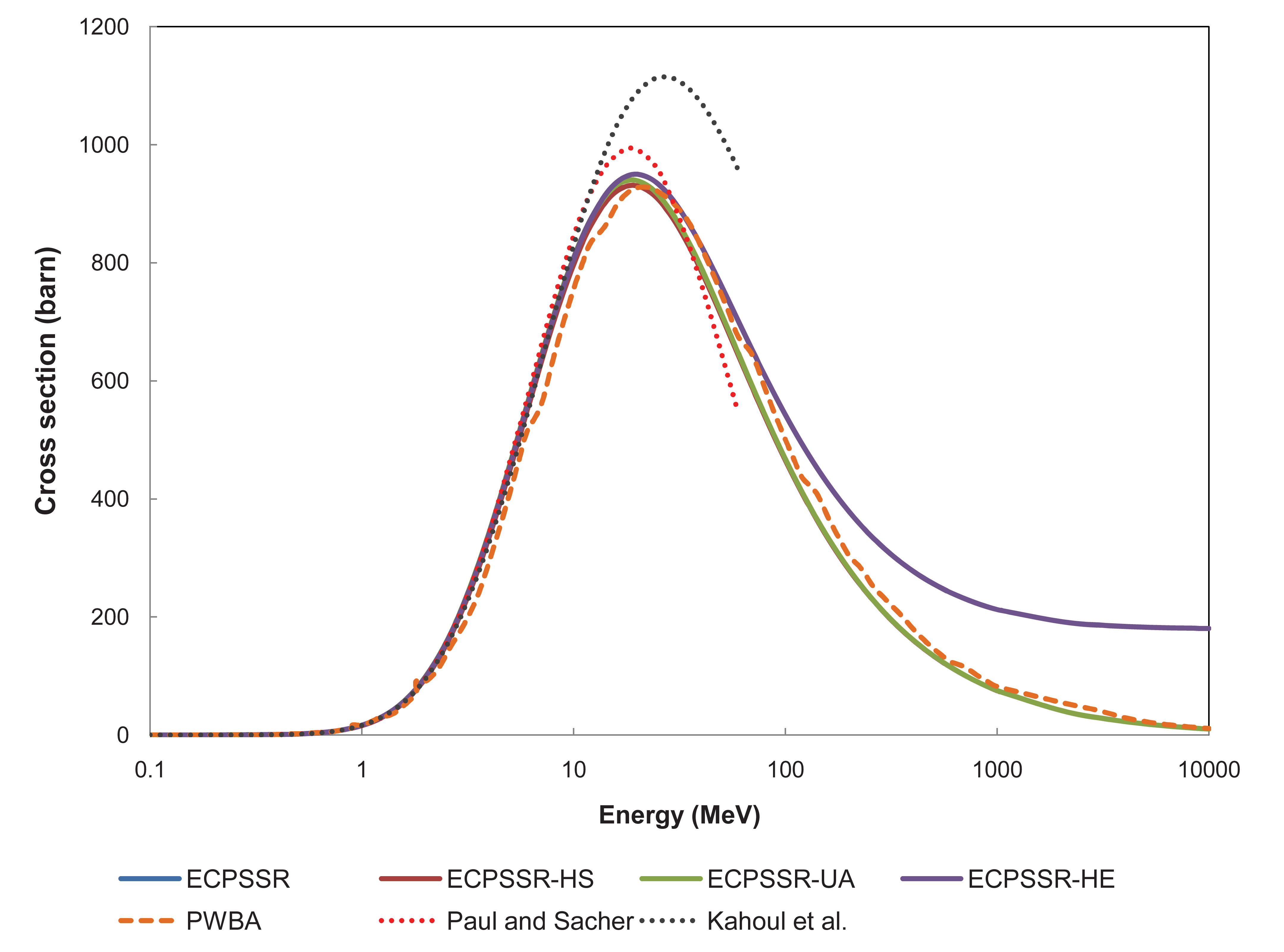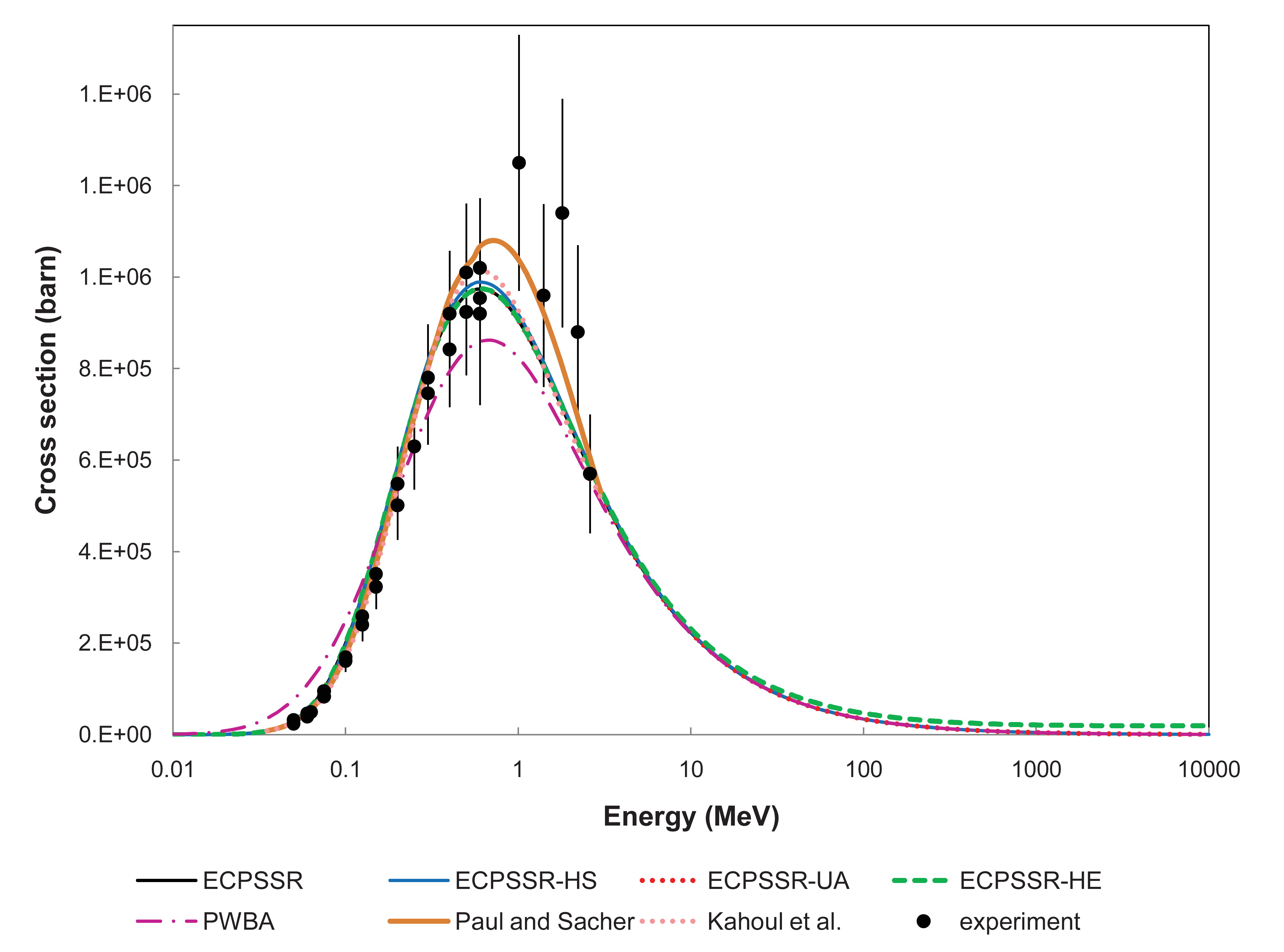Alternative models for impact ionisation by hadrons and PIXE
Early developments of proton and \(\alpha\) particle impact ionisation cross sections in Geant4 are reviewed in a detailed paper devoted to PIXE simulation with Geant4 [eal09]. This article also presents alternative developments for PIXE simulation, their validation with respect to experimental data and the first Geant4-based simulation involving PIXE in a concrete experimental use case: the optimization of the graded shielding of the X-ray detectors of the eROSITA [eal07] mission. The new developments described in [eal09] are released in Geant4 in the pii package (in source/processes/electromagnetic/pii).
The developments for PIXE simulation described in [eal09] provide a variety of proton and \(\alpha\) particle cross sections for the ionisation of K, L and M shells:
theoretical calculations based on the ECPSSR [BL81] model and its variants (with Hartree-Slater corrections [Lap05], with the “united atom” approximation [Cip07b] and specialized for high energies [Lap08]),
theoretical calculations based on plane wave Born approximation (PWBA),
empirical models based on fits to experimental data collected by Paul and Sacher [PS89] (for protons, K shell), Paul and Bolik [PB93] (for \(\alpha\), K shell), Kahoul et al. [KND08]) (for protons, K, shell), Miyagawa et al. [MNM88], Orlic et al. [OST94] and Sow et al. [SOLT93] for L shell.
The cross section models available in Geant4 are listed in Table 17.
Particle, shell |
Model |
Z range |
|---|---|---|
Protons, K shell |
||
ECPSSR |
6-92 |
|
ECPSSR High Energy |
6-92 |
|
ECPSSR Hartree-Slater |
6-92 |
|
ECPSSR United Atom |
6-92 |
|
ECPSSR reference [PS89] |
6-92 |
|
PWBA |
6-92 |
|
Paul and Sacher |
6-92 |
|
Kahoul et al. |
6-92 |
|
Protons, L shell |
||
ECPSSR |
6-92 |
|
ECPSSR United Atom |
6-92 |
|
PWBA |
6-92 |
|
Miyagawa et al. |
40-92 |
|
Orlic et al. |
43-92 |
|
Sow et al. |
43-92 |
|
Protons, M shell |
||
ECPSSR |
6-92 |
|
PWBA |
6-92 |
|
\(\alpha\), K shell |
||
ECPSSR |
6-92 |
|
ECPSSR Hartree-Slater |
6-92 |
|
ECPSSR reference [PB93] |
6-92 |
|
PWBA |
6-92 |
|
\(\alpha\), L and M shell |
||
ECPSSR |
6-92 |
|
PWBA |
6-92 |
|
The calculation of cross sections in the course of the simulation is based on the interpolation of tabulated values, which are collected in a data library. The tabulations corresponding to theoretical calculations span the energy range between 10 keV and 10 GeV; empirical models are tabulated consistently with the energy range of validity documented by their authors, that corresponds to the range of the data used in the empirical fits and varies along with the atomic number and sub-shell.
ECPSSR tabulations have been produced using the ISICS software [LC96][Cip07a], 2006 version; an extended version, kindly provided by ISICS author S. Cipolla [Cip08], has been exploited to produce tabulations associated with recent high energy modelling developments [Lap08].
An example of the characteristics of different cross section models is illustrated in Fig. 23. Fig. 24 shows various cross section models for the ionisation of carbon K shell by proton, compared to experimental data reported in [PS89].

Fig. 23 Cross section for the ionisation of copper K shell by proton impact according to the various implemented modeling options: ECPSSR model, ECPSSR model with “united atom” (UA) approximation, Hartree-Slater (HS) corrections and specialized for high energies (HE); plane wave Born approximation (PWBA); empirical models by Paul and Sacher and Kahoul et al. The curves reproducing some of the model implementations can be hardly distinguished in the plot due to their similarity.

Fig. 24 Cross section for the ionisation of carbon K shell by proton impact according to the various implemented modeling options, and comparison with experimental data [PS89]: ECPSSR model, ECPSSR model with “united atom” (UA) approximation, Hartree-Slater (HS) corrections and specialized for high energies (HE); plane wave Born approximation (PWBA); empirical models by Paul and Sacher and Kahoul et al. The curves reproducing some of the model implementations can be hardly distinguished in the plot due to their similarity.
The implemented cross section models have been subject to rigorous statistical analysis to evaluate their compatibility with experimental measurements reported in [PS89], [OSaSMT94], [SC84] and to compare the relative accuracy of the various modelling options.
The validation process involved two stages: first goodness-of-fit analysis based on the \(\chi^2\) test to evaluate the hypothesis of compatibility with experimental data, then categorical analysis exploiting contingency tables to determine whether the various modelling options differ significantly in accuracy. Contingency tables were analyzed with the \(\chi^2\) test and with Fisher’s exact test.
The complete set of validation results is documented in [eal09]. Only the main ones are summarized here; Geant4 users interested in detailed results, like the accuracy of different cross section models for specific target elements, should should refer to [eal09] for detailed information.
Regarding the K shell, the statistical analysis identified the ECPSSR model with Hartree-Slater correction as the most accurate in the energy range up to approximately 10 MeV; at higher energies the ECPSSR model in its plain formulation or the empirical Paul and Sacher one (within its range of applicability) exhibit the best performance. The scarceness of high energy data prevents a definitive appraisal of the ECPSSR specialization for high energies.
Regarding the L shell, the ECPSSR model with “united atom” approximation exhibits the best accuracy among the various implemented models; its compatibility with experimental measurements at 95% confidence level ranges from approximately 90% of the test cases for the L\(_3\) sub-shell to approximately 65% for the L\(_1\) sub-shell. According to the results of the categorical analysis, the ECPSSR model in its original formulation can be considered an equivalently accurate alternative. The Orlic et al. model exhibits the worst accuracy with respect to experimental data; its accuracy is significantly different from the one of the ECPSSR model in the “united atom” variant.
The implementation of these models for the hadron impact ionisation process
is included in the G4hImpactIonisation class, which is largely based on
the original G4hLowEnergyIonisation process.
Bibliography
- BL81
W. Brandt and G. Lapicki. Energy-loss effect in inner-shell coulomb ionization by heavy charged particles. Phys. Rev. A, 23:1717–1729, 1981.
- Cip08
S. Cipolla. Isics, 2008 version. 2008. Private communication: S Cipolla, Creighton Univ., Omaha NE 68178.
- Cip07a
S. J. Cipolla. An improved version of isics: a program for calculating k-, l-, and m-shell cross sections from pwba and ecpssr theory using a personal computer. Comp. Phys. Comm., 176:157–159, 2007.
- Cip07b
S. J. Cipolla. The united atom approximation option in the isics program to calculate k-, l-, and m-shell cross sections from pwba and ecpssr theory. Nucl. Instrum. Meth. B, 261():142–144, 2007.
- eal09(1,2,3,4,5)
M. G. Pia et al. Pixe simulation with geant4. IEEE Trans. Nucl. Sci., 56(6):3614–3649, 2009.
- eal07
P. Predehl et al. Erosita. In Proc. of the SPIE, volume 6686, 668617–9. 2007.
- KND08
A. Kahoul, M. Nekkab, and B. Deghfel. Empirical k-shell ionization cross-sections of elements from $^4$be to $^92$u by proton impact. Nucl. Instrum. Meth. B, 266():4969–4975, 2008.
- Lap05
G. Lapicki. The status of theoretical k-shell ionization cross sections by protons. X-Ray Spectrom., 34:269–278, 2005.
- Lap08(1,2)
G. Lapicki. Scaling of analytical cross sections for k-shell ionization by nonrelativistic protons to cross sections by protons at relativistic velocities. J. Phys. B, 41:115201–115213, 2008.
- LC96
Z. Liu and S. J. Cipolla. Isics: a program for calculating k-, l-, and m-shell cross sections from ecpssr theory using a personal computer. Comp. Phys. Comm., 97:315–330, 1996.
- MNM88
Y. Miyagawa, S. Nakamura, and S. Miyagawa. Analytical formulas for ionization cross sections and coster-kronig corrected fluorescence yields of the ll, l2, and l3 subshells. Nucl. Instrum. Meth. B, 30:115–122, 1988.
- OST94
I. Orlic, C. H. Sow, and S. M. Tang. Semiempirical formulas for calculation of l subshell ionization cross sections. International Journal of PIXE, 4(4):217–230, 1994.
- OSaSMT94
I. Orlic, J. Sow, and and S. M. Tang. Experimental l-shell x-ray production and ionization cross sections for proton impact. At. Data Nucl. Data Tab., 56:159–210, 1994.
- PB93(1,2,3)
H. Paul and O. Bolik. Fitted empirical reference cross sections for k-shell ionization by alpha particles. At. Data Nucl. Data Tab., 54:75–131, 1993.
- PS89(1,2,3,4,5,6)
H. Paul and J. Sacher. Fitted empirical reference cross sections for k-shell ionization by protons. At. Data Nucl. Data Tab., 42:105–156, 1989.
- SC84
R. S. Sokhi and D. Crumpton. Experimental l-shell x-ray production and ionization cross sections for proton impact. At. Data Nucl. Data Tab., 30:49–124, 1984.
- SOLT93
C. H. Sow, I. Orlic, K. K. Lob, and S. M. Tang. New parameters for the calculation of l subshell ionization cross sections. Nucl. Instrum. Meth. B, 75:58–62, 1993.